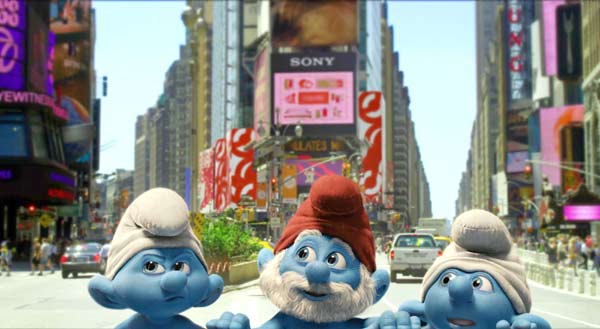“在那山的那邊、海的那邊有一群藍(lán)精靈……”經(jīng)歷過上世紀(jì)八十年代的人們對(duì)這首兒歌想必是耳熟能詳,藍(lán)精靈快樂生活的場(chǎng)景也都?xì)v歷在目。2011年的今天,藍(lán)精靈即將卷土重來(lái),以立體動(dòng)畫的形式重上大熒幕。二三十歲的讀者們大可趁機(jī)懷舊一把,看看陪伴自己成長(zhǎng)的小伙伴怎樣舊貌換新顏;年輕的讀者也不妨體驗(yàn)一下,看看曾經(jīng)風(fēng)靡一時(shí)的經(jīng)典如何獨(dú)具魅力。

蘊(yùn)翎 選編 曾真 譯注
|
Who was the man that dropped out of art school almost as soon as he entered, and whose teacher told him he had no future in cartooning? Who was the mastermind behind the blue empire that helped define a generation of kids in the 1980s? The television show he inspired ran for nearly ten years. Little blue and white creatures were everywhere—and one man from Belgium was responsible for it all. The Smurfs begin with a man named Pierre Culliford, otherwise known as Peyo. Peyo was born in Brussels, Belgium in 1926 to an English father and a Belgian mother. He studied at the Academy of Fine Arts in Brussels but dropped out at 17. He looked in the paper for a job. Two caught his eye: offers for a dental assistant and an illustrator. When he presented himself to the dentist, he was told he was just 15 minutes too late! Peyo began work at the Compagnie Belge d’Animation (CBA), a small Belgian animation studio, where he met a few of his future colleagues, like André Franquin, Morris and Eddy Paape. When the studio folded after the war, the other artists went to work for Dupuis, but Peyo, a few years younger than the others, was not accepted. Peyo followed suit in 1947 and created Johan for La Derniere Heure. This “prototype” Johan strip was about a medieval page boy and ran for a single year. In 1954, Peyo decided to follow Morris to the popular weekly comic Spirou. Johan needed some retooling, so his hair color was changed from blond to black. He was given a “peewee” sidekick. Pirlouit (also called Peewee) was his mischeivous new companion who brought levity and conflict to the comic. The comic was renamed Johan et Pirlouit. It was, in fact, Johan et Pirlouit that gave birth to Peyo’s most popular creation... The Smurfs! 1958 was the year it all began—the year that would change Peyo’s life and legacy forever. In 1958, Peyo created a Johan et Pirlouit story called The Flute with Six Holes. In this story, Johan and Pirlouit meet our little blue buddies, The Smurfs, for the very first time. The Smurfs are three apples tall and live during the medieval era. Peyo stated that the Smurfs were inspired by the trolls of Nordic fairy tales, and that the Smurfs’ blue pallor was selected because it was a color he thought children would like. Dupuis, the company that published Spirou, released a Pirlouit figurine that same year as well. Slowly but surely Peyo’s Smurf figurine army was beginning to assemble. Dupuis wanted to see if The Smurfs could be spun-off from Johan et Pirlouit. They tested The Smurfs comic in special mini-stories to see if the Smurfs would be popular solo. And yes, readers loved The Smurfs! The Smurfs soon eclipsed Johan and Pirlouit in popularity. The Smurfs were popular basically everywhere French-language comics were sold in the 1960s. A Smurf film was the next logical step—a full length Smurf movie, was released in 1976. All the Smurfs needed to do next was to conquer the rest of the world in multiple languages. In 1978, Father Abraham released his famous Smurf Song. The song was an instant hit, and most importantly, it was in English. Finally, the Smurfs were accessible and relevant to English-speaking audiences. Almost the instant after Father Abraham released his song, the UK, Australia and North America began to take notice of the Smurfs. The stage was set for an American invasion—one started in the most peculiar way imaginable: all thanks to a little girl. Melissa Silverman loved the Smurfs. Melissa wanted a Smurfs TV show. Melissa could make it happen. How could this little girl make a Smurfs TV show? Anything is possible when your dad is NBC television executive Fred Silverman! Mr. Silverman contacted Dupuis and the famous Smurf animated series was born. It really was that simple. Peyo could not have imagined how popular his little blue friends would become. The sheer volume of Smurf figurines, dolls, and music sold in the American market was astounding. It was absolutely impossible to be alive in the United States and not see, hear, and experience the Smurfs in the 1980s. They were everywhere: even live Smurf mascots could be found at amusement parks! The Smurfs were icons of the 1980s but things started to slow down in 1989. Once The Smurfs cartoon show ended, Smurf mania began to subside. It was an amazing decade... but the Smurf fun isn’t over yet! The Smurfs didn’t disappear, however. Nothing could stop the success of Peyo’s creation—not even his own death. Peyo died of a heart attack on Christmas Eve, December 24, 1992. Peyo’s heirs have continued to support the Smurfs with collectibles, promotions and publications throughout Europe and the rest of the world. In America, Peyo’s legacy continues with the Columbia Pictures Smurf Movie being released in 2011, part of a planned trilogy. Thanks to the movie, we are finally getting new waves of Smurf collectibles too. It is an amazing time for Smurf collectors because of all the exciting new merchandise (toys, books, clothing and more) currently available for sale. Peyo’s creation is alive and smurfing! Oh...and how did Peyo he get his nickname, you ask? And what about the word “Smurf”? First of all, “Smurf” is not an invented word—it originates squarely with the German surnames “Schlumpff”. The story goes a little something like this... Peyo was at the dinner table and found himself at a loss for a word. He ended up saying, “Pass the... er... er... Schtroumpf”. The word had just the kind of audial quality he was seeking for his newest creation. Thus, the Smurfs were born. As for Peyo, the name is the result of his English cousin’s inability to pronounce his Dutch name, “Pierrot”, properly. |
是誰(shuí)剛剛踏進(jìn)藝術(shù)學(xué)校的大門不久就輟學(xué)了?是誰(shuí)的老師說(shuō)他在動(dòng)畫界毫無(wú)前途可言?又是誰(shuí)創(chuàng)建了藍(lán)精靈王國(guó),讓20世紀(jì)80年代的孩子們能夠更準(zhǔn)確地說(shuō)明自己那代人的特征呢? 在他的靈感激發(fā)下創(chuàng)作的動(dòng)畫片連續(xù)播放了將近十年。在那個(gè)年代,那群藍(lán)白相間的小精靈無(wú)所不在——這一切都得益于一個(gè)比利時(shí)人的創(chuàng)作。 藍(lán)精靈出自皮埃爾?庫(kù)利福特之手,他還有個(gè)別名叫貝約。貝約1926年生于比利時(shí)布魯塞爾,父親是英國(guó)人,母親是比利時(shí)人。 他曾就讀于布魯塞爾美術(shù)學(xué)院,卻在17歲時(shí)輟學(xué)。之后,他開始在報(bào)紙上找工作,看上了兩個(gè)職位:牙醫(yī)助手和插畫師。不過,等他見到牙醫(yī)的時(shí)候,卻被告知就來(lái)晚了那么15分鐘! 于是,貝約開始在比利時(shí)動(dòng)畫公司(CBA)工作。那是一間小型動(dòng)畫工作室,在那兒,他認(rèn)識(shí)了幾個(gè)后來(lái)的同事,包括安德烈?弗朗坎、莫里斯和艾迪?帕皮。二戰(zhàn)后,工作室倒閉,別的插圖師都去了迪普伊公司工作,只有年紀(jì)稍輕的貝約沒被錄用。 1947年,貝約也終于加入了迪普伊,還為《最后一刻》創(chuàng)作了約翰這個(gè)角色。這個(gè)“樣板化”的約翰連環(huán)畫講的是一個(gè)中世紀(jì)小聽差的故事,連續(xù)刊載了一年。1954年,貝約決定追隨莫里斯,為當(dāng)時(shí)流行的連環(huán)畫周刊《斯皮魯》工作。約翰這個(gè)人物形象需要進(jìn)行一些加工,于是貝約把他的金發(fā)改成了黑發(fā),還給他添了個(gè)名叫“皮威”的小伙伴。皮魯伊(也叫皮威)是約翰的新伙伴,喜歡調(diào)皮搗蛋,他的出現(xiàn)給這部連環(huán)畫帶來(lái)了變化和矛盾沖突。而連環(huán)畫的名字也因此改成了《約翰和皮威》。 事實(shí)上,正是《約翰和皮威》造就了貝約最受歡迎的作品——藍(lán)精靈!藍(lán)精靈誕生于1958年,這一年將永遠(yuǎn)改變貝約的人生和他將來(lái)的遺產(chǎn)。 1958年,貝約給《約翰和皮威》系列寫了一個(gè)故事,名叫《六孔長(zhǎng)笛》。在這個(gè)故事里,約翰和皮威第一次結(jié)識(shí)了我們的那些藍(lán)色小朋友——藍(lán)精靈。藍(lán)精靈家族生活在中世紀(jì),成員身高大致相當(dāng)于三個(gè)蘋果疊在一起。貝約曾經(jīng)說(shuō)過,藍(lán)精靈的創(chuàng)作靈感來(lái)自北歐神話中的巨人們,而為藍(lán)精靈選擇淺藍(lán)色調(diào)是因?yàn)樗X得孩子們會(huì)喜歡。那一年,《斯皮魯》雜志的出版商迪普伊還推出了皮魯伊的小人偶。不過,貝約的藍(lán)精靈小人偶此刻正邁著穩(wěn)穩(wěn)的步子,慢慢招兵買馬呢。 之后,迪普伊公司想看看藍(lán)精靈是不是能從《約翰和皮威》中脫離出來(lái)、自立門戶,于是特別制作了一些藍(lán)精靈的連環(huán)畫小故事,來(lái)測(cè)試藍(lán)精靈是否會(huì)受歡迎。結(jié)果是肯定的,讀者都可喜歡藍(lán)精靈了!藍(lán)精靈的受歡迎程度很快便超過了約翰和皮威。 20世紀(jì)60年代,藍(lán)精靈在幾乎所有出售法語(yǔ)連環(huán)畫的地方都流行起來(lái)。接下來(lái),制作一部藍(lán)精靈電影就成了順理成章的事。1976年,一部標(biāo)準(zhǔn)長(zhǎng)度的藍(lán)精靈電影面世了。對(duì)于藍(lán)精靈來(lái)說(shuō),下一步要做的就是采用多種語(yǔ)言來(lái)征服全世界了。 1978年,亞伯拉罕神父推出了他那首赫赫有名的“藍(lán)精靈之歌”。這首歌一面世便大獲成功,最重要的是,歌詞是用英語(yǔ)寫的。至此,藍(lán)精靈終于進(jìn)入了英語(yǔ)國(guó)家觀眾的視線范圍,跟他們建立了聯(lián)系。亞伯拉罕神父的新歌剛一發(fā)布,英國(guó)、澳大利亞和北美洲就開始盯上藍(lán)精靈了。一切準(zhǔn)備就緒,藍(lán)精靈該進(jìn)入美國(guó)了——第一步特別讓人難以想象:這全都得歸功于一個(gè)小女孩。 梅麗莎?西弗曼很喜歡藍(lán)精靈,她想要一部藍(lán)精靈動(dòng)畫片。可是,梅麗莎沒法實(shí)現(xiàn)這個(gè)愿望。這么個(gè)小姑娘怎么拍得出藍(lán)精靈的動(dòng)畫片來(lái)呢?不過,如果你爸爸是美國(guó)國(guó)家廣播公司的電視節(jié)目總監(jiān)弗雷德?西弗曼,那就一切皆有可能了!西弗曼先生跟迪普伊公司取得了聯(lián)系,鼎鼎大名的藍(lán)精靈系列動(dòng)畫片就這樣誕生了。事情真的就這么簡(jiǎn)單。 貝約想不到自己的藍(lán)色小朋友會(huì)這么受歡迎。光是在美國(guó)市場(chǎng)上賣出的藍(lán)精靈小人偶、洋娃娃和唱片的數(shù)量就大得驚人。對(duì)于20世紀(jì)80年代生活在美國(guó)的人來(lái)說(shuō),要想不看、不聽和不接觸藍(lán)精靈的故事,是絕對(duì)不可能的。他們無(wú)處不在,就連在游樂園里都可以看到工作人員扮成的藍(lán)精靈!藍(lán)精靈是20世紀(jì)80年代的偶像,但一切從1989年起便放緩了腳步。藍(lán)精靈動(dòng)畫片放完了,對(duì)于藍(lán)精靈的狂熱便開始降溫。那是一個(gè)令人驚嘆的年代……不過,藍(lán)精靈所能帶來(lái)的樂趣卻并沒有就此結(jié)束! 但是藍(lán)精靈沒有消失;沒有什么能夠阻止貝約的作品繼續(xù)蓬勃發(fā)展——連他的過世也不例外。1992年12月24日,圣誕前夜,貝約因心臟病突發(fā)而辭世。此后,他的繼承人繼續(xù)在歐洲和世界各地維護(hù)藍(lán)精靈這一形象,進(jìn)行宣傳、發(fā)行紀(jì)念品和出版物。在美國(guó),貝約的遺作還在延續(xù):2011年,哥倫比亞電影公司即將推出藍(lán)精靈電影,并計(jì)劃將其拍成三部曲。這部電影的出現(xiàn)也讓我們終于可以買到新一批的藍(lán)精靈紀(jì)念品了。對(duì)于喜歡收集藍(lán)精靈紀(jì)念品的人來(lái)說(shuō),這可是一個(gè)難得的好機(jī)會(huì),不少令人興奮的新玩意兒(玩具、圖書、服裝等)都有得賣。貝約的作品仍然生機(jī)勃勃,活力四射! 哦……對(duì)了,你問貝約這個(gè)昵稱是怎么來(lái)的?還有,藍(lán)精靈的英文名“Smurf”又是怎么來(lái)的?首先,Smurf這個(gè)詞不是生造出來(lái)的——它是正兒八經(jīng)地從德語(yǔ)名字“Schlumpff”演化而來(lái)的。這其中的故事大致是這樣的:有一天吃晚飯的時(shí)候,貝約發(fā)現(xiàn)自己忘了有個(gè)詞該怎么說(shuō),于是只好說(shuō):“請(qǐng)把那個(gè)……呃……呃……Schtroumpf遞給我一下。”當(dāng)時(shí),他正在替自己最新創(chuàng)作的形象起名字,而這個(gè)詞聽起來(lái)感覺剛剛好,于是藍(lán)精靈就此得名了。至于貝約這個(gè)昵稱嘛,是因?yàn)樗莻€(gè)英國(guó)的姑表親念不好他的荷蘭語(yǔ)名字“Pierrot”。 (來(lái)源:英語(yǔ)學(xué)習(xí)雜志) |
